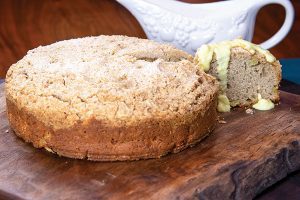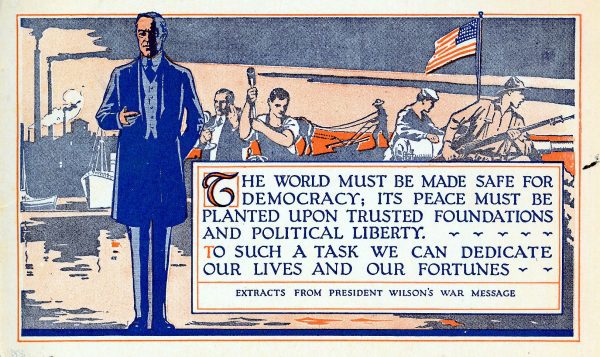1 of 130
Photos by Greg Catalano
Photos by Greg Catalano
By Heidi Sutton
Share a sweet way to complete your St. Patrick’s Day meal in style with Irish Apple Cake, a classic dessert to top off a filling celebration. This version is easy enough to prepare with a handful of everyday ingredients for the cake, a crumbly topping and homemade custard for the finishing touch. The best part? It’s equally as scrumptious for breakfast as it is an after-dinner dessert. Serve it with a delicious cup of Maple Irish Coffee any leprechaun would approve of.
Irish Apple Cake

YIELD: Makes 10 servings
INGREDIENTS:
Cake:
3 cups self-rising flour
1/2 tablespoon cinnamon
1/4 teaspoon cloves
1/4 teaspoon nutmeg
1/4 teaspoon ginger
1 stick butter, cubed
3/4 cup sugar
4 apples of choice, peeled and cubed
2 eggs
1 cup half-and-half
Topping:
1/2 stick butter
3/4 cup flour
1 cup brown sugar
Custard:
6 large egg yolks
6 tablespoons sugar
1 1/2 cups half-and-half
2 teaspoons vanilla
DIRECTIONS:
Preheat oven to 375 F. Grease and flour 9-inch round springform pan.
To make cake: In large bowl, sift flour with cinnamon, cloves, nutmeg and ginger. Using fork, cut butter until mixture resembles crumbs. Add sugar and apples; mix well. Stir in eggs and half-and-half until mixture reaches thick, dough-like batter. Pour batter into prepared pan.
To make topping: In bowl, mix butter, flour and sugar to create crumbled mixture. Sprinkle on top of batter in pan. Bake 1 hour. Check with toothpick to make sure middle is completely done. If not, bake 5-10 minutes. Let cool on rack.
To make custard: Whisk egg yolks and sugar. In saucepan, bring half-and-half to boil. Add one spoonful half-and-half at a time to egg mixture, whisking while adding. Once whisked together, return to saucepan and stir over medium heat until thickened, about 4 minutes. Remove from heat and whisk in vanilla. Serve custard over cake.
Maple Irish Coffee

YIELD: Makes 1 serving
INGREDIENTS:
1/2 cup hot coffee
2 teaspoons brown sugar
2 tablespoons whiskey
1 tablespoon half-and-half
1 teaspoon maple extract
DIRECTIONS:
Stir coffee and brown sugar in mug. Add whiskey, half-and-half and extract; mix well. Serve warm. Top with whipped cream and maple sugar, if desired.
The Kings Park St. Patrick’s Day parade returned for another successful year on Saturday, March 2.
The Kings Park St. Patrick’s Day Parade Committee organized the annual parade, which is both the first and largest on Long Island.
It was led by Grand Marshal Marge Connick, who was selected due to her involvement in the community and her care to patients in her 48 years as a nurse.
The parade began at noon, on the corner of Pulaski Road and Lou Avenue, in front of Celtic Crossing and ending in front of St. Joseph’s RC Church.
The parade route was festooned with green shamrocks, as well as American and Irish flags. In addition, the parade featured nearly 20 bands, of which 14 were bagpipe bands. The Suffolk County Police, Nassau County Police and New York City Police highlighted the parade with their respective bagpipe bands.
Also included was the Westchester Fire Department band, St. Anthony’s Pipe Band, and two of Long Island’s finest bagpipe bands, Roisin Dubh and the Saffron Pipes. The Kings Park High School Band, the Sunrisers Drum and Bugle Corps, a banjo band, and various Irish bands also marched at the event. Bands from 11 fire districts were in the line-of-march, including Smithtown and Huntington Fire Departments.
To round out the festive occasion, various civic and businesses attended including: the Kings Park Fire Department, Kings Park Central School District, the American Legion and Veterans of Foreign Wars, Ancient Order of Hibernians, Knights of Columbus, Catholic Daughters of America, and Kings Park Chamber of Commerce.
The selection of Marge as the Grand Marshal was hailed by many community members. Awards were presented to the best float — the heralded Claddaugh Cup —- best storefront design and best Kings Park School float.
The Parade Committee consists of a relatively small group: Sue Benjes, Peter Biggane, Diana Brown, Jessica Caruso, Gerry and Robert Creighton, Kevin Johnston, Tom Lamb, Kevin Malloy, Melissa McDougall, Terry Roche, Colleen Shivers, Roy Starke, Michael Sullivan and Darryl Weir.
By Heidi Sutton
Whether or not your ancestors hail from the Emerald Isle, everyone is guaranteed to enjoy a family-friendly (and dog-friendly) St. Patrick’s Day Parade. Here are the ones on the North Shore this year over the next few weeks. And don’t forget to wear green!
Center Moriches
Moriches Chamber of Commerce’s 20th annual St. Patrick’s Day Parade will take place on Sunday, March 10 at 2 p.m. The parade begins on Lake Avenue and ends at Railroad Avenue. This year’s Grand Marshal is George Keller. For more information, visit www.moricheschamber.org.
Farmingdale
Farmingdale presents its 10th annual St. Patrick’s Day Parade on Sunday, March 10 at 2 p.m. The parade steps off at Northside School and proceeds down Main Street to the Village Green. This year’s Grand Marshal is Patrick J. Ryder. Call 516-286-7800 for more information.
Huntington
The Ancient Order of Hibernians (AOH) invites the community to its 90th annual St. Patrick’s Day Parade in Huntington on Sunday, March 10 from 2 to 3 p.m. Grand Marshal Monsignor Steven Camp will lead the procession down New York Avenue to Main Street. Long Island’s oldest and largest, the parade will feature dozens of pipe bands. For more information, visit www.huntingtonhibernian.com.
Miller Place-Rocky Point
The Friends of St. Patrick will host the 72nd annual Miller Place-Rocky Point St. Patrick’s Day Parade on Sunday, March 10 at 1 p.m. sharp. The 2.8-mile parade starts at Harrison Avenue and Route 25A in Miller Place and then finishes at Broadway in Rocky Point. This year’s Grand Marshal is Vincent Worthington. For further information, visit www.friendsofstpatrick.com or call 631-473-5100.
Ronkonkoma
The 35th annual Ronkonkoma St. Patrick’s Day Parade will be held on Sunday, March 24 at 2 p.m.Grand Marshal Greg Plante will lead the parade from Hawkins Avenue at School Street, south down Hawkins Ave ending at Thorne Street. Call 631-304-6303 or visit www.ronkonkomaparade.org.
St. James
St. James Chamber of Commerce presents the 40th annual St. James St. Patrick’s Day Parade on Saturday, March 9 from 1 to 2 p.m. The parade will step off along Lake Avenue from Woodlawn Avenue to the viewing stand in front of the gazebo ending just before St James Elementary School, rain or shine. Featuring scouts, dance troupes, pipe bands, school bands, floats, fire trucks and more. The grand marshal will be Peter Scully. 631-584-8510.
The Friends of St. Patrick have announced that the 72nd annual Miller Place-Rocky Point St. Patrick’s Day Parade is scheduled for Sunday, March 10 starting at 1 p.m. sharp.
Vincent Worthington, a long- standing member and Sergeant of Arms for the organization has been named 2024 Grand Marshal. Worthington has been a proud member of the Suffolk County Sheriff’s Office since 1996. After moving to Wading River with his wife in 2002, he became involved in the community, and was particularly drawn to The Friends of St. Patrick, becoming a member himself in 2005.
As his family expanded to include 3 sons, Worthington became increasingly involved in raising funds to support the parade and organizing the parade itself. Vincent has traced his Irish ancestry back to 1744. He is the seventh of seven children who were steeped in Irish traditions: dedication to family, strong work ethic, commitment to community and church, music and the Irish sense of humor.
The parade will kick off at Harrison Avenue in Miller Place and ends at Broadway in Rocky Point. For more information, visit www.thefriendsofstpatrick.com.


By Beverly C. Tyler
Celebrating holidays and other special days was and still is an important milestone in people’s lives. Diaries, journals and letters provide some of the earliest records of seasonal activity and how people connected with each other to mark occasions. In America, before the telephone became a standard household item, family members and friends stayed in touch through the U.S. Postal Service.
In 1873, a new phenomenon began when the United States Postal Service issued the first penny postcards. During the first six months they sold 60 million. With the postcard, brevity was essential due to the small space provided. Long descriptive phrases and lengthy expressions of affection, which then were commonly used in letter-writing, gave way to short greetings.
The postcard was an easy and pleasant way to send a message. A postcard sent from one town in the morning or afternoon would usually arrive in a nearby town that afternoon or evening. A postcard sent from another state would not take much longer.
As the telephone became more widely used, the postcard became less and less important as a means of daily communications. However, it provided us with a view of the early years of the twentieth century that became a permanent record of contacts between family members and friends.
This past Monday we celebrated Presidents Day. We should remember it’s not merely a day off from work or an excuse for a long weekend getaway. It’s a time to reflect on the impact of historical figures and the importance of leadership, both nationally and within our community.
Originally established to honor George Washington’s birthday, Presidents Day has evolved into a day of recognition for all U.S. presidents. It’s a day to celebrate the individuals who have held our nation’s highest office and led us through triumphs and challenges, shaping the course of history with their decisions and actions.
One of the primary reasons that Presidents Day holds such significance is because it serves as a reminder of the democratic principles upon which our nation was founded. The peaceful transition of power from one president to the next is a hallmark of our democracy, underscoring the importance of leadership in ensuring the continuity and stability of our government.
While Presidents Day traditionally celebrates the contributions of past presidents to the nation as a whole, it also offers us an opportunity to reflect on the importance of local leadership and its direct influence on our daily lives.
In our community, local leaders play a vital role in shaping the policies, programs and initiatives that directly impact our neighborhoods, schools, businesses and quality of life. From town council members to school board trustees, mayors to county legislators, these individuals make decisions that affect everything from local taxes and infrastructure to education and public safety.
This federal holiday serves as a reminder of the significance of civic engagement and the power of community involvement. It’s a time to recognize the dedication and hard work of our local leaders who devote themselves to serving our community and addressing the needs of its residents.
Moreover, Presidents Day encourages us to reflect on the values and principles guiding our community and consider how we can contribute to its betterment. Whether it’s through volunteering, participating in local government or simply being a responsible and engaged citizen, each of us has a role to play in shaping the future of our community.
Presidents Day provides an opportunity to celebrate the diversity and inclusivity of our community. Just as our nation is comprised of individuals from various backgrounds and walks of life, so too is our local community. Presidents Day reminds us of the importance of unity and collaboration in overcoming challenges and achieving common goals.
Each year as we observe Presidents Day, we should take a moment to express gratitude for the local leaders who work to improve our community. Let us also reaffirm our commitment to active citizenship and civic engagement, recognizing that positive change begins at the grassroots level.
Looking for a way to romance your sweetheart for Valentine’s Day? The Jazz Loft, 275 Christian Avenue in Stony Brook, will supply the live jazz music, champagne and chocolate. You supply the romance.
The Jazz Loft presents “Here’s to the Ladies,” on Friday, February 16 at 7 p.m., featuring The Jazz Loft All Stars”, with Tom Manuel on cornet/vocals; Dean Johnson on bass; Steve Salerno on guitar; Ray Anderson on trombone and Darrell Smith on drums.
The performance repertoire is songs written for women, about women, to women, by women– It’s all about the ladies when Valentine’s Day comes to the Jazz Loft. All tickets are $40. The event includes a glass of champagne and deluxe chocolate.
“Our Valentine’s Day performances at the Jazz Loft are all about the LADIES– period!” said Jazz Loft founder Tom Manuel. “So, gentlemen, if you’re looking for someplace that will celebrate them properly, the Loft is the place to be!”
The Jazz Loft is located just 90 minutes from New York City and is the only music venue on Long Island that features exclusively Jazz music. For tickets visit: https://www.thejazzloft.org/calendar
By David Dunaief, M.D.

In February, we celebrate Valentine’s Day, a celebration of those we love, alongside American Heart Month, an invitation for us to build our awareness of heart-healthy habits.
The good news is that heart disease is on the decline due to several factors, including improved medicines, earlier treatment of risk factors, and an embrace of lifestyle modifications. While we are headed in the right direction, we can do better. Heart disease is ultimately preventable.
Can we reduce heart disease risks?
Major risk factors for heart disease include obesity, high cholesterol, high blood pressure, smoking and diabetes. Sadly, rates of both obesity and diabetes are rising. For patients with type 2 diabetes, 70 percent die of cardiovascular causes (1).
Key contributors also include inactivity and the standard American diet, which is rich in saturated fat and calories (2). This drives atherosclerosis, fatty streaks in the arteries.
Another potential risk factor is a resting heart rate greater than 80 beats per minute (bpm). In one study, healthy men and women had 18 and 10 percent increased risks of dying from a heart attack, respectively, for every increase of 10 bpm over 80 (3). A normal resting heart rate is usually between 60 and 100 bpm. Thus, you don’t have to have a racing heart rate, just one that is high-normal. All of these risk factors can be overcome.
When does medication help?
Cholesterol and blood pressure medications have been credited to some extent with reducing the risk of heart disease. Compliance with taking blood pressure medications has increased over the last 10 years from 33 to 50 percent, according to the American Society of Hypertension.
Statins have also played a key role in primary prevention. They are effective at lowering lipid levels, including total cholesterol and LDL — the “bad” cholesterol. In addition, they lower the inflammation levels that contribute to cardiovascular disease risk. The Jupiter trial showed a 55 percent combined reduction in heart disease, stroke and mortality from cardiovascular disease in healthy patients — those with a slightly elevated level of inflammation and normal cholesterol profile — with statins.
The downside of statins is their side effects. Statins have been shown to increase the risk of diabetes in intensive dosing, compared to moderate dosing (4). Many who are on statins also suffer from myopathy (muscle pain and cramping).
I’m often approached by patients on statins with this complaint. Their goal when they come to see me is to reduce and ultimately discontinue statins by modifying their diet and exercise plans.
Lifestyle modification is a powerful ally.
How much do lifestyle changes reduce heart disease risk?
The Baltimore Longitudinal Study of Aging investigated 501 healthy men and their risk of dying from cardiovascular disease. The authors concluded that those who consumed five servings or more of fruits and vegetables daily with <12 percent saturated fat had a 76 percent reduction in their risk of dying from heart disease compared to those who did not (5). The authors theorized that eating more fruits and vegetables helped to displace saturated fats from the diet. These results are impressive and, to achieve them, they only required a modest change in diet.
The Nurses’ Health Study shows that these results are also seen in women. Lifestyle modification reduced the risk of sudden cardiac death (SCD) (6). Many times, this is the first manifestation of heart disease in women. The authors looked at four parameters of lifestyle modification, including a Mediterranean-type diet, exercise, smoking and body mass index. There was a decrease in SCD that was dose-dependent, meaning the more factors incorporated, the greater the risk reduction. There was as much as a 92 percent decrease in SCD risk when all four parameters were followed. Thus, it is possible to almost eliminate the risk of SCD for women with lifestyle modifications.
In a cohort study of high-risk participants and those with heart disease, patients implemented extensive lifestyle modification: a plant-based, whole foods diet accompanied by exercise and stress management. The results showed an improvement in biomarkers, as well as in cognitive function and overall quality of life. The best part is the results occurred over a very short period — three months from the start of the trial (7). Outside of this study environment, many of my own patients have experienced similar results.
How do you monitor your heart disease risk?
Physicians use cardiac biomarkers, including blood pressure, cholesterol and body mass index, alongside inflammatory markers like C-reactive protein to monitor your risk. Ideally, if you need to use medications to treat risk factors for heart disease, it should be for the short term. For some patients, it may be appropriate to use medication and lifestyle changes together; for patients who take an active role, lifestyle modifications may be sufficient.
By focusing on developing heart-healthy habits, you can improve the likelihood that you— and those you love — will be around for a long time.
References:
(1) Diabetes Care. 2010 Feb; 33(2):442-449. (2) Lancet. 2004;364(9438):93. (3) J Epidemiol Community Health. 2010 Feb;64(2):175-181. (4) JAMA. 2011;305(24):2556-2564. (5) J Nutr. March 1, 2005;135(3):556-561. (6) JAMA. 2011 Jul 6;306(1):62-69. (7) Am J Cardiol. 2011;108(4):498-507.
Dr. David Dunaief is a speaker, author and local lifestyle medicine physician focusing on the integration of medicine, nutrition, fitness and stress management. For further information, visit www.medicalcompassmd.com or consult your personal physician.

Huntington Town Clerk Andrew P. Raia will be performing his annual marriage ceremonies as the Town’s Marriage Officer on Valentine’s Day, Feb. 14, from 9 a.m. to 4 p.m. by appointment in the Town Board Room at Huntington Town Hall, 100 Main Street, Huntington.
There is no charge to the couple for the ceremony and their guests are welcome to attend the reception.
Please note:
Marriage Ceremonies: A marriage ceremony may only take place after 24 hours issuance of a marriage license (more information); vow renewals do not require a waiting period.
Domestic Partnership Registry: Find more information on requirements for a Domestic Partnership Registry.
“Love is in the air once again at Huntington Town Hall this Valentine’s Day,” said Town Clerk Raia. “It is an honor and a privilege to join two people in a lifetime of love and commitment and it’s the part of my job that is the most heartwarming.”
To make an appointment, please call the Town Clerk’s Office at (631) 351-3216 or email [email protected].
